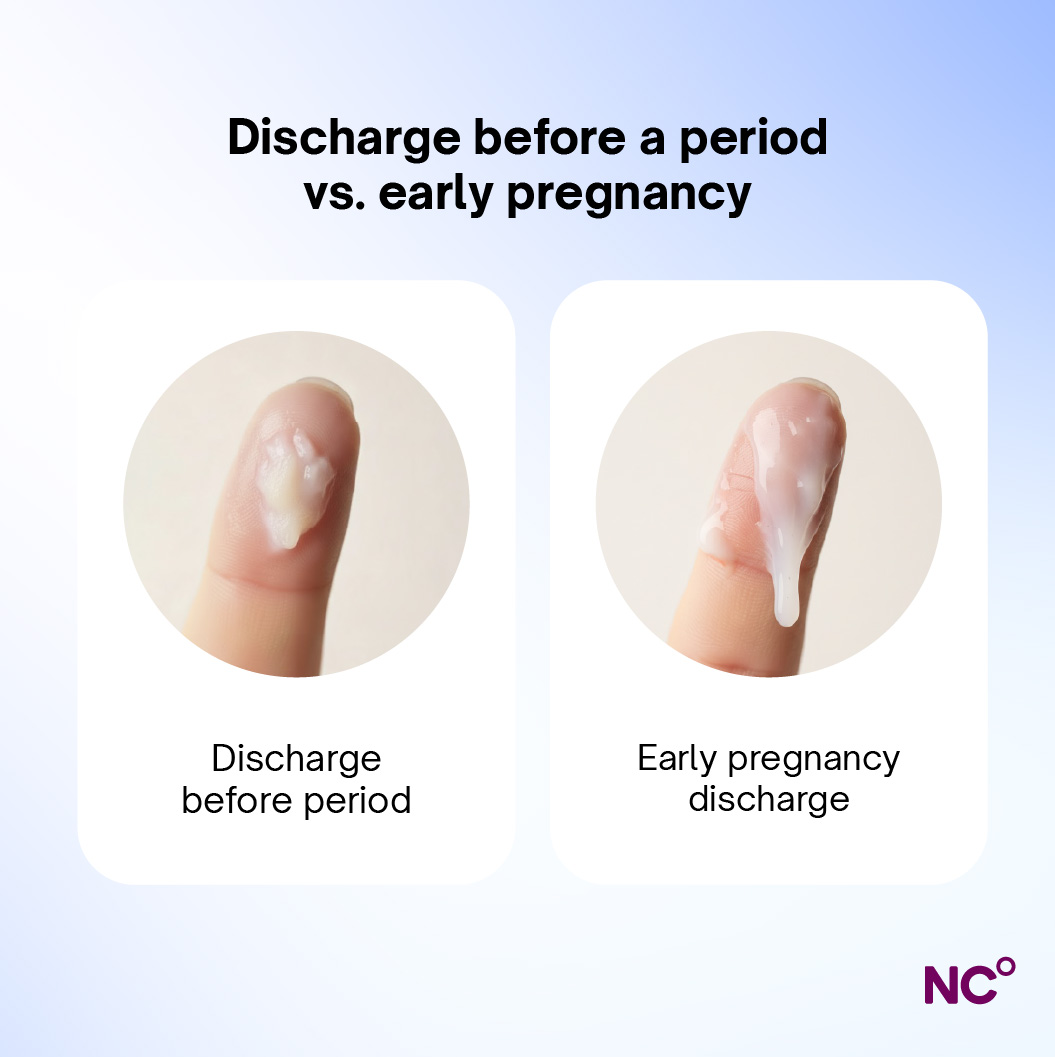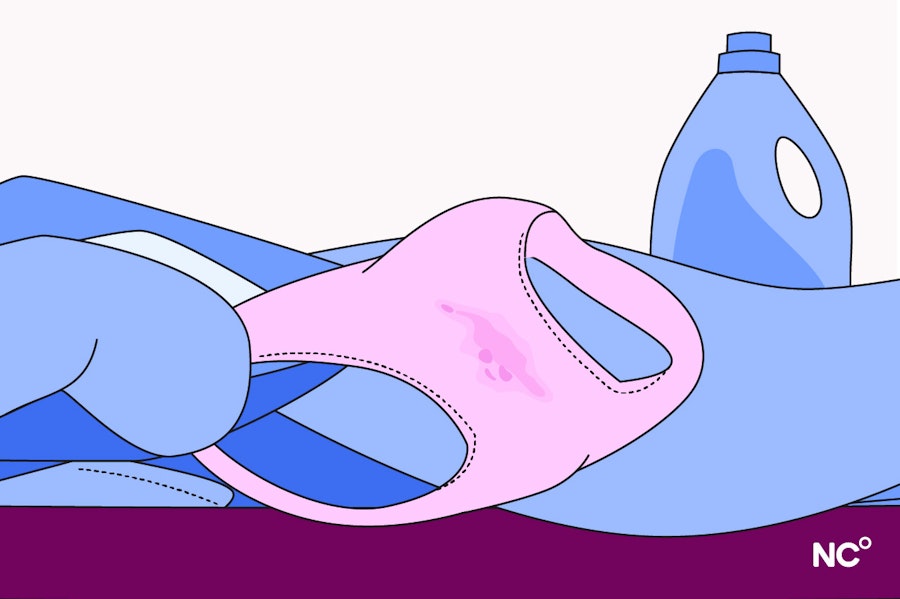Clear discharge: Causes & clear jelly-like discharge explained
Follows NC° Editorial Policy
At Natural Cycles, our mission is to empower you with the knowledge you need to take charge of your health. At Cycle Matters, we create fact-checked, expert-written content that tackles these topics in a compassionate and accessible way. Read more...
Key takeaways
- Clear discharge is a normal signal of a healthy, functioning reproductive system
- Discharge helps the vagina self-clean and also indicates certain hormonal changes happening throughout the menstrual cycle
- Any abnormal changes to discharge, like a strong, unpleasant odor or green coloring, may be a symptom of an underlying infection that warrants attention from your healthcare provider
Have you ever noticed clear discharge in your underwear or when you use the bathroom? You may be wondering if this is normal, and rest assured, it typically is. Vaginal discharge is one of the many ways that the body communicates with us about what’s happening hormonally, and it also helps the vagina clean itself each day [1].
Thick, clear, sometimes jelly-like discharge is usually an indicator that your body is functioning normally, but if it’s accompanied by other symptoms such as itching or a strong, unpleasant odor, it may be a sign of infection [1]. In this article, we’ll go over exactly what clear discharge is, what causes this type of discharge, and how it relates to your fertility journey.
What is clear discharge?
Clear vaginal discharge is completely natural. It’s actually made up of mostly water, but it also contains some secretions from certain internal glands along with tiny microorganisms and cells that the body regularly sheds. Normal discharge doesn’t cause any irritation and usually doesn’t have a strong, unpleasant odor, although a light scent is completely normal. It appears clear or white in color, and it may be slippery, wet, thick, or even sticky in consistency. These qualities will likely change over the course of your menstrual cycle each month, depending on different hormonal influences (more on that later). It can be present at any age, although it’s most common from puberty until menopause [1, 2, 3].
Why is clear discharge normal?
Varying amounts of clear to white vaginal discharge is just your body’s way of keeping itself healthy and clean, so it’s perfectly normal as long as it does not have a strong, unpleasant odor or abnormal consistency. But the key to identifying your personal “normal” discharge is to get familiar with your cycle patterns. The qualities and quantity of discharge you experience over the course of a menstrual cycle will likely change, but will also follow a pattern from cycle to cycle. Tracking these changes over time with Natural Cycles can help you gain a deeper awareness of your body and quickly spot changes to your discharge in terms of smell, color, amount, or texture [1, 4].
Causes of clear vaginal discharge
There are a variety of reasons why the body produces clear discharge. Below, we’ll go through the physiological reasons for it, as well as the hormonal changes and lifestyle factors that can affect discharge throughout your cycle.
Physiological causes
Discharge is necessary during our reproductive years to help the vagina stay healthy. By constantly working to shed those secretions and cells, the vagina maintains a delicate, balanced ecosystem within our bodies. It can vary by life stage, though — quantity of discharge can increase particularly during puberty, pregnancy, and postpartum, but it usually decreases after menopause [4, 5].
Hormonal changes
One of the main reasons why your discharge might look and feel different throughout the cycle is the natural rise and fall of certain hormones. There is a type of discharge, known as cervical mucus, that changes throughout your cycle and can be an indicator of your fertility. Fluctuations of sex hormones like estrogen and progesterone can lead to changes in the quality and quantity of this discharge. You may notice:
- Very little to no mucus for a few days after your period ends
- Sticky or tacky mucus appears as you start to approach ovulation
- A lot of thick clear jelly-like mucus that resembles raw egg whites for a fewdays around ovulation. This is a peak fertile sign, and one of the clearest indicators our body gives us that ovulation is near or happening.
- Less mucus post-ovulation until your period begins again [6]
This pattern may vary person to person, depending on your cycle length and other hormonal factors as well. For example, if you’re breastfeeding or on hormonal birth control, your discharge pattern may look a bit different [6].
Lifestyle and health factors
Factors outside of hormone fluctuations and life stages can also influence discharge patterns. Personal hygiene habits, using lube, semen that’s present in the area after sex, some medications, and certain medical conditions and procedures can all affect and alter your typical discharge patterns. It’s a good idea to consult your healthcare professional if you’re noticing anything out of the ordinary, as they can assess the root cause and treat it accordingly [4, 6].
Decoding clear discharge
With this wide variety of factors in mind, you may be wondering what exactly your clear discharge is trying to tell you. Below, we’ll go through some of the most common reasons why you could be experiencing thick, clear, jelly-like discharge.
Excessive or watery clear discharge
If you’re noticing a higher amount of discharge than normal, or that it’s extra watery or slippery in consistency than you’re used to, this is likely an indication that you’re approaching ovulation [6]. You’ll also experience larger amounts of watery discharge if you’re sexually active, using birth control containing estrogen, and during pregnancy [1].
Thick, clear, jelly-like discharge
If you’ve noticed that your clear discharge is thicker or more jelly-like in consistency, this could mean that you're currently experiencing ovulation. This change in consistency is your body’s way of preparing for a potential pregnancy [6].
Clear discharge and early pregnancy signs
Thick, clear jelly-like discharge may also be an early sign of pregnancy, and you’ll likely notice more vaginal discharge than usual throughout pregnancy as well. It plays an important role in supporting a healthy pregnancy by making it more difficult for infections to travel up to the uterus [7].
Towards the end of pregnancy (especially in the last few weeks), you may notice that your discharge resembles a pink mucus that’s also sticky and/or jelly-like in texture. This is sometimes called a “show,” a “bloody show,” or a “mucus plug,” and it is a sign that your body is preparing for birth [7].

How to manage and monitor clear discharge
Again, clear vaginal discharge is a normal part of life, and not something to be self-conscious about. While there isn’t a way to prevent vaginal discharge or lower the amount of it, there are a few measures you can take to avoid unnecessary irritation and/or dryness, and to make sure that your personal hygiene is in good shape:
- Wash the skin around the vulva daily using warm water and a gentle, mild, non-perfumed soap (or just rinse it with warm water). Learn more about how to clean your vagina and vulva here.
- Avoid perfumed soaps, gels, wipes, or sprays
- Do not use deodorants or douches in the area
- Avoid tight-fitting clothing [1, 7]
Logging the characteristics of your discharge over time in the Natural Cycles app can allow you to use this information to flag if and when you notice changes in your discharge patterns that may reflect temporary lifestyle changes or require medical attention.
When to see a doctor
See your healthcare provider if you notice any of the following changes to your vaginal discharge:
- A strong, unpleasant odor
- Clumpy texture (like cottage cheese)
- Green or yellow coloring
- Itching
- Pelvic pain
- Abnormal bleeding
- Blisters or sores
These may indicate an underlying infection, and your healthcare provider can help you determine next steps for treatment [1].
Get to know your body better with Natural Cycles
Thick, clear, jelly-like discharge is an important element of a healthy functioning reproductive system. Whether you’re early in your reproductive years, starting on your pregnancy journey, or experiencing perimenopause, logging your symptoms with Natural Cycles can provide clarity on what’s normal and what’s not when it comes to discharge and more. This information not only helps you understand your body’s natural rhythms, but it can also support conversations with your healthcare provider if something feels off. See how Natural Cycles can help you take charge of your reproductive health today.
Did you enjoy reading this article?
